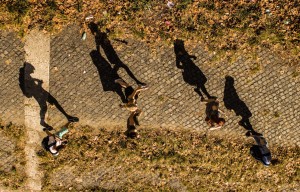Look at Me! Look at Me! (Spotlights and Shadows)
Most of us are dying to be seen – to be noticed, loved, and understood – whether or not we’re totally conscious of this. I always made a performance of it. As a little girl I’d joyfully entertain family guests with a song, as a teenager I dreamed of winning an Oscar, and as an adult I still seek opportunities to get on stage. I long to glow in the spotlight, feeling the soundwall of applause vibrating in my belly. Nothing feels more affirming…at least for a minute.
In order to have that much light shining down on me, I’m bound to get a bit washed out and blinded. Turns out, there are parts of me I don’t want to be seen. Not if I’m not met with applause and kisses and adoration. But the more the blinding lights are shone on the “good” parts, the more the rest of me gets cast away into the shadows, left to fester and wither, neglected and (rightfully) pissed off. And, despite whatever praise others might send my way, I may be left feeling a bit empty or depressed because I’m not being loved in my entirety. (This is why movie stars and rock stars don’t tend to be fulfilled by living the dream).
Why must we have castaways in the first place? When we’re little and dependent on our caregivers’ love for our survival, we make adjustments to who we are based upon the reactions we elicit from those we depend upon. They teach us what parts of ourselves are most acceptable and which parts should be hidden away. This is a completely unavoidable fact of life: Our very human parents and our very human cultures have rules and regulations and particular values. This is inescapable. However, we can see how the more rigid the rules of the world around us, the less free we feel to “be ourselves.” So, everything that doesn’t elicit a loving response becomes part of the “bad” and we naturally try to rid ourselves of those parts. Carl Jung called these discarded parts The Shadow.
But just because mom didn’t like it when you showed your anger, or because your religion didn’t like it when you expressed your sexuality, doesn’t mean these parts are actually “bad.” To split ourselves into categories of bad and good causes us great suffering because we become unintegrated, unwhole.
But hold on. The goal isn’t necessarily to show everyone everything. Of course we should “be ourselves,” but that’s a pretty tall and complicated order. Instead, the goal is for us to learn to see and care for the whole of ourselves and to let those closest to us in on it too. Then we have more choice about what we reveal or don’t reveal based on what’s contextually appropriate. We can still be our professional self at work, for instance, but with enough awareness of the context to understand when vulnerability is helpful. Or we can enjoy the glow of the spotlight without our sense of worth depending on a standing ovation. By opening up to ourselves we get to experience the lesser known incredible gifts we carry – parts of us that weren’t given enough sunlight and water to thrive in this world. (Like my repressed inner molecular biologist.)
So how does one begin to shift the lighting? How do we allow ourselves to honor the good, the bad, and the ugly of our true selves especially when, for us performer types, this means not always chasing that high? I suppose the simplest answer would be to practice. Which isn’t very appealing to those of us who like being perfect on the first shot – especially when it might earn us some applause. So what does it even mean to practice? It might mean trying to show up with a little more of ourselves in close relationships – like telling a friend you’re scared or hurt if your MO is to put on a brave face and smile. Practicing might mean staying away from Facebook for a bit if presenting yourself to your friends is starting to feel more about “Likes” than about connecting.
As tough as this may seem, here’s the incentive: a more meaningful sense of self and self-worth, unrelated to hands clapping and Facebook “likes.” A relationship to ourselves that transcends what other people need us to be and that helps guide us as we’re faced with choice after choice throughout our lives. And when we’re feeling that deep and meaningful sense of self, we can connect to others in a deeper, more compassionate, and authentic way. We can see others more clearly too.
In therapy, all the attention is on you, but in a different kind of way. There are no blinding spotlights, no audience, and not usually applause (though I have done it…). Your therapist, instead, is a mirror reflecting back what is present in the room. That might mean your therapist sees more of you than many others see. I can’t tell you how many high-powered, successful, “perfect” Fortune 500 whatevers finally find a place to fall apart in therapy. Being seen by a compassionate other can be a profound path towards reintegrating these cast-off parts, that hour becoming a safe environment for practicing showing up in an authentic way.
For more reading on the shadow, check out Robert Bly’s A Little Book on the Human Shadow, a beautifully poetic (and very little) companion for those inspired to begin the process of illumination and reintegration.

